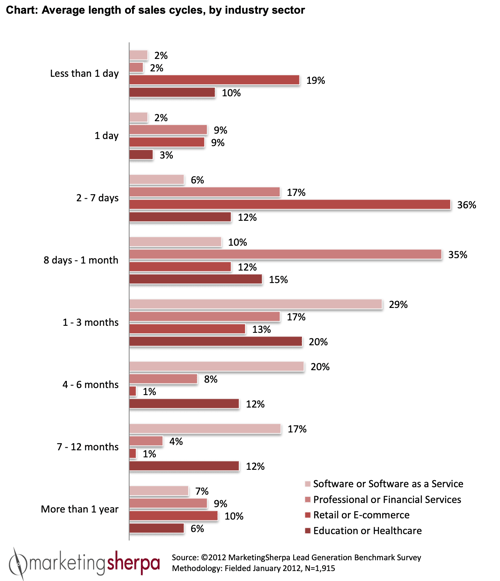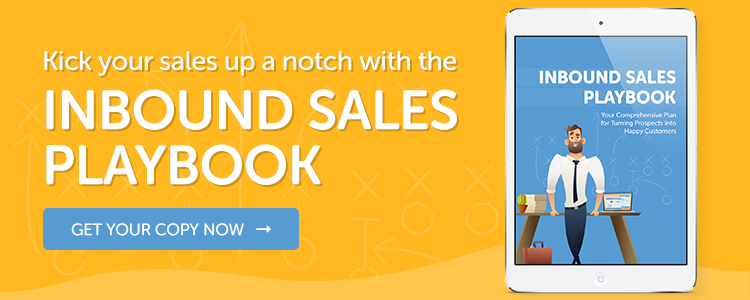It can take a long time to attract and engage with leads and move them through the buyer’s journey. Realistically, the entire process can take months.
Every lead requires resources and attention throughout the process. For any business, that timeline is far from ideal, especially if hiccups and unforeseen obstacles draw it out even longer.
That’s why eliminating challenges to shorten your sales cycle is such an advantage.
What Is a Sales Cycle?
Your sales cycle is made up of every action that you, as a salesperson, make to close a new customer. This isn’t to be confused with a sales methodology, which is the framework in which you practice your sales cycle.
Instead, the cycle is the step by step process of moving your leads down their individual journeys.
Understanding your sales cycle gives you and your business a closer look at the efficiency of your sales operations. By tracking and analyzing the length of the cycle, you can see how your business compares to the rest of the industry.
Understanding Sales Cycle Stages and Length
To fully comprehend how it comes into play, you need to understand the five clear stages of a sales cycle.
1. Prospect
Prospecting is where the real labor takes place. You’re finding leads, identifying them as sales qualified, and matching them to your buyer personas.
This stage is all in an effort to find leads that are going to be the best fit for your business.
2. Connect
Finding prospects is only the first half of the battle. It’s important that you connect with new leads and spark a relationship quickly. If you have a mutual acquaintance, ask to be introduced.
Practice social selling to increase your engagement on Twitter, Facebook, and LinkedIn. Contact them over phone or email.
Whatever gets you talking – and therefore connecting – with your new prospects, pursue it strategically. Always lead with what value you can provide for them.
3. Research
Upon finding an interested prospect, your next step should be finding out as much information as possible about them. What company are they with? What position? How did they find you?
Make a discovery call to find out their needs and if you’re able to actually meet those needs. Studying up on a lead will help you further qualify them for your business.
4. Present
This is where you and your team build a pitch directly speaking to a prospect’s specific business needs. Each presentation should be customized to each unique prospect.
Usually, you’re speaking to a team of decision makers to answer any questions that they may have, but the room can be made up of a variety of parties.
5. Close
This is the moment every salesperson is waiting for. If there are any questions or concerns remaining from the prospect, they’re addressed during this stage. After all the details are fleshed out, it’s time to close.
You’ll receive either a “yes” or “no.” If you get a yes, a contract is drawn up, reviewed, and signed. If it’s a no, that doesn’t necessarily mean it’s time to give up.
Inquire about what their hesitations are. If you’re unable to find a solution, then it’s time to walk away for the time being.
Seeing how each stage plays into you landing a new customer, it’s obvious how important sales cycle management can be, right?
Evaluating each stage, looking at what’s working well and what can be improved, can define the success of your entire sales process, especially when it comes to long sales cycles.
4 Challenges of Long Sales Cycles
Sales cycle lengths can differ from industry to industry. MarketingSherpa’s report found the average length of sales cycles, broken down by industry.

Source: MarketingSherpa
As seen above, longer sales cycles are associated more with SaaS. Honestly, B2B in general requires a lot of time to maintain.
In fact, Implisit's research found how long it takes for B2B leads to become opportunities, for those opportunities to close, and the overall length of the average B2B sales cycle.

Source: Geckoboard
Speaking plainly, that’s a lot of time for things to go awry. Over the course of 100+ days, your sales team can face a lot of challenges.
Turning the Lead to a Sales-Ready Prospect
It’s not often that you’ll find a lead who’s ready to make a sale right from the start. If you are getting those, then by all means, share your secrets in our comments.
But for those generating prospects that need to be converted, then lead nurturing should be your best friend.
With such long sales cycles, it’s important to nurture leads through the entire process. Keeping in touch with potential customers makes it easier to convert them when they’re ready.
If you’re not able to provide valuable content and touch base authentically, then you’ll likely churn through them before you get them very far into your cycle.
Maintaining Engagement Over Time
A large part of converting leads is keeping them on a sales team’s radar. As the months pass, it can be difficult to remember every single prospect that you’ve interacted with. But neglecting them does nothing for your business.
Learning how to balance existing SQLs with new prospects can be a juggle. As new leads come in, older ones get lost in the weeds. Who’s to say which is a higher priority? Who do you give more attention and for how long?
Out of sight, out of mind can become a serious obstacle here.
Keeping Your Sales Team Energized
Along the same vein, your sales team is going to have an even harder time staying engaged with leads if they aren’t engaged with the process itself.
Unfortunately, salespeople can become either bored or frustrated from working with hesitant or difficult leads.
It’s hard to remain emotionally invested as the sales cycle drags on. The thrill of a quick win isn’t present to fuel the team, and discouragement or apathy can fall into play.
Ensuring Marketing and Sales Alignment
Probably one of the most detrimental challenges that can impact a sales cycle would be when marketing and sales lose communication. That loss of alignment can hurt lead nurturing, which then breeds further challenges like the ones listed above.
And, most of the time, once the two teams fall out of sync, it takes a lot to get them on the same page again.
The teams can start working separately from one another, making decisions and pursuing different goals that aren’t going to benefit the entire business.
5 Tips For Overcoming Long Sales Cycle Challenges Using Inbound Tactics
Inbound practices help eliminate a lot of obstacles by minimizing the gaps between departments and sales cycle steps.
By aligning every aspect of a business (marketing, sales, and service), every team is working toward the same goal with open transparency.
Here are some easy tips to implement that can help you optimize your long sales cycle:
Make the Most of Automation Tools.
Personalized emails, scheduled blog posts, templates, and other similar automation tools allow teams to prioritize engaging with leads.
Through segmentation, salespeople can communicate with leads with specific qualifications, providing an easier means of converting them.
They can also shorten the sales cycle by qualifying leads more efficiently, educating them through content before they even interact with sales, and providing faster communication.
Marketing automation is centered around personalized and unique engagement, so make sure that you aren’t sending vague or general messages to your prospects. Leverage the tools at your disposal to their full potential and target your audiences strategically.
Encourage an Insider to Recommend You.
Writing targeted content for audiences who have audiences of their own comes with a lot of benefits. For example, CEOs are decision makers, but they often tune into what their reports share and recommend to them.
By creating content that speaks to lower leadership, you can spread brand awareness to others inside the company that have the power to close a deal with you.
You can get buy in from others inside the company, which can lead to them recommending you when it’s time to sign a deal.
Maintain Your Authority Status.
Of course, that buy in can only be earned if you’re publishing relevant content that presents you as authoritative. A strong content marketing strategy not only generates leads, but it also validates your position in your industry.
You likely have at least a few competitors. What can set you apart from them is the value you’re offering freely, before a sale even happens.
Start a campaign in thought leadership, offering tips, lists, and explanations on a variety of industry-relevant topics that will interest your audience. Doing so will keep your business at the top of your audience’s mind when they consider their needs and look for solutions.
Adopt a Paid Search Strategy.
Long sales cycles usually mean that your leads are doing a lot of research, and your position on those SERPs determines the amount of business you get.
It’s not uncommon for businesses to frown at the idea of paid search spots or ads, but they provide incredibly valuable research.
Implementing a paid search strategy that leverages top of the funnel content and offers will bring in a ton of traffic.
One of the obstacles we mentioned was how not every lead is sales ready, right? Well, this strategy will help you draw those leads in who are only just beginning their search.
Make sure to research which keywords are going to attract the most prospects to your landing pages, blogs, and products.
Build and Maintain an Emotional Connection.
Consumers value authenticity and relationships in their buyer's journeys now more than ever. Give them what they want by actually learning about them and putting genuine care and emphasis on meeting their needs.
A lead can tell when you’re reading them as just another number in your sales count and may react negatively to being treated as such. Not to mention that not many act as impulsive buyers anymore, especially not in B2B companies. They do their research, build rapport, and make sure that they’re investing in the solution.
Help them get to that point by maintaining an emotional, friendly connection. By the time you close the deal, they should be a familiar acquaintance.
Sales cycles can be extremely long and tedious, especially for B2B and industries like SaaS. Months at a time can be spent nurturing a lead toward a close. It’s important to be patient.
All the while, applying inbound techniques can help speed the sales cycle along at a natural, comfortable pace. Identify what your team’s greatest challenges are and start practicing new methods to knock them down.


Micah Lally
I’m a Content Writer at Bluleadz. I’m a big fan of books, movies, music, video games, and the ocean. It sounds impossible to do all of those at the same time, but you’d be surprised by the things I can accomplish.